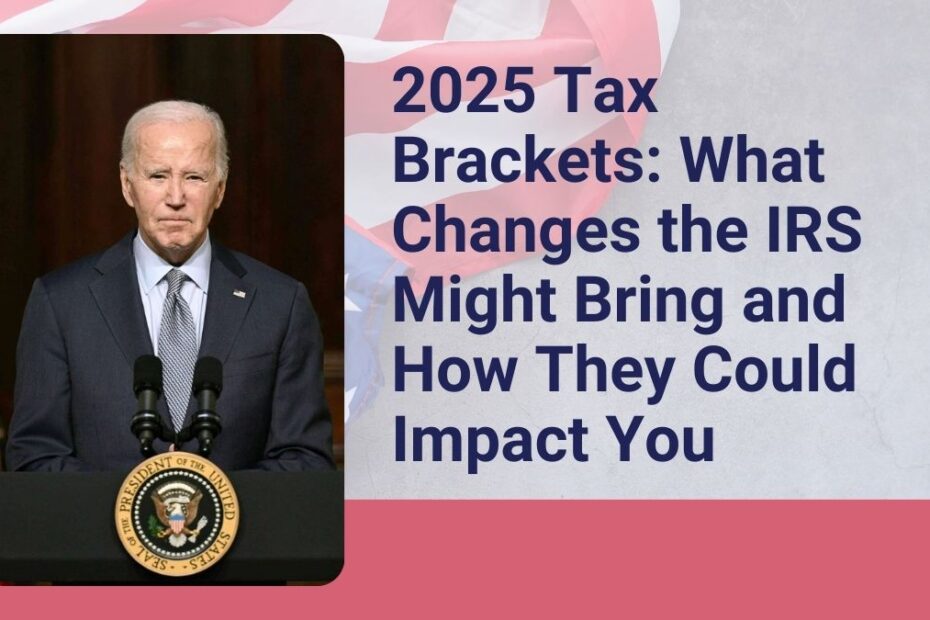As we approach 2025, taxpayers are preparing for new adjustments to federal income tax brackets. The IRS sets new tax brackets each year to account for inflation and economic changes, with projections showing a moderate 2.8% adjustment for the 2025 tax year.
While this increase is smaller than previous years, it still holds significance for how much income you will owe in taxes next year. Let’s dive into what you can expect, including bracket changes, standard deductions, and how these adjustments could impact your finances.
Understanding IRS Tax Brackets
Tax brackets represent the percentage of taxes you owe on different portions of your income. The U.S. has a progressive tax system, meaning as your income rises, so does the percentage of your income that is taxed.
Tax rates for 2025 are expected to remain at the same levels: 10%, 12%, 22%, 24%, 32%, 35%, and 37%, but the income thresholds for each bracket will increase.
Why the Adjustment?
The IRS adjusts tax brackets every year to account for inflation. Without these adjustments, taxpayers could experience “bracket creep,” where their income is taxed at higher rates due to inflation, even if their purchasing power has not increased. This helps ensure taxpayers aren’t unfairly penalized by higher taxes just because of inflation-based wage increases.
In 2025, the projected inflation adjustment is smaller than in previous years, reflecting a cooling inflation environment after the rapid increases seen in 2022 and 2023.
For example, the tax brackets increased by 7.1% in 2023 and 5.4% in 2024. The expected 2.8% rise for 2025 reflects more stable economic conditions.
Projected 2025 IRS Tax Brackets
While the official 2025 tax brackets will be confirmed later, current projections from sources like Wolters Kluwer and Bloomberg Tax suggest that the income thresholds for each bracket will rise modestly. Here are some expected changes:
| Filing Status | 2024 Income Bracket | 2025 Projected Income Bracket |
|---|---|---|
| 10% Bracket | $0 to $23,200 (married) | $0 to $23,850 (married) |
| 12% Bracket | Over $23,200 to $94,300 | Over $23,850 to $96,950 |
| 22% Bracket | Over $94,300 to $201,050 | Over $96,950 to $206,700 |
| 24% Bracket | Over $201,050 to $383,900 | Over $206,700 to $394,600 |
| 32% Bracket | Over $383,900 to $487,450 | Over $394,600 to $501,050 |
| 35% Bracket | Over $487,450 to $731,200 | Over $501,050 to $751,600 |
| 37% Bracket | Over $731,200 | Over $751,600 |
These increases mean that you will need to earn more income to move into higher tax brackets, which could potentially reduce the amount of tax owed by many households.
Standard Deduction Adjustments for 2025
In addition to the tax brackets, the standard deduction, which reduces your taxable income, is also adjusted annually for inflation. For 2025, the standard deduction amounts are expected to rise slightly:
| Filing Status | 2024 Standard Deduction | 2025 Projected Standard Deduction |
|---|---|---|
| Married Filing Jointly | $29,200 | $30,000 |
| Heads of Household | $21,900 | $22,500 |
| All Other Taxpayers | $14,600 | $15,000 |
These modest increases in the standard deduction can help offset the effect of inflation by lowering the amount of your income subject to taxes.
Key Factors Influencing the 2025 Tax Brackets
- Inflation Trends: The 2025 tax brackets are expected to see the smallest increase in three years due to cooling inflation. This shift follows the record-high inflation of 2022 and marks a return to more stable economic conditions.
- Chained Consumer Price Index (CPI): The IRS uses the “chained CPI” to calculate inflation adjustments. This index accounts for changes in consumer behavior in response to price changes, offering a more accurate measure than the traditional CPI.
- Impact of Tax Cuts and Jobs Act (TCJA): The individual tax rates, deductions, and other provisions set by the TCJA in 2017 are still in place through 2025. If Congress does not take further action, these provisions are set to expire, which could lead to significant changes in tax rates starting in 2026.
Conclusion
The IRS’s expected tax bracket adjustments for 2025 reflect a stabilizing economy with lower inflation compared to previous years.
While the adjustments will not be as large as in 2023 or 2024, they still offer taxpayers some relief by raising income thresholds and slightly increasing standard deductions. Keeping an eye on these changes will help individuals plan their finances effectively for the upcoming tax season.
FAQs
The IRS typically announces official tax bracket adjustments towards the end of the preceding year, so the 2025 tax brackets should be confirmed by late 2024.
The tax brackets are expected to increase by about 2.8% due to inflation, a smaller adjustment compared to previous years.
The tax rates will remain the same as in 2024: 10%, 12%, 22%, 24%, 32%, 35%, and 37%. However, the income thresholds for each bracket will be adjusted upward.
If Congress does not extend the provisions of the TCJA, tax rates and deductions will revert to their pre-2017 levels in 2026. This could lead to higher tax bills for many Americans.
Yes, the standard deduction is projected to rise slightly in 2025, with the largest increase being for married couples filing jointly, where the deduction will go up to $30,000.
References
- AOL Finance, “What to Expect from the 2025 Tax Brackets,” 2024.
- Wolters Kluwer, “Projected 2025 Tax Brackets and Adjustments,” 2024.
- Bloomberg Tax, “2025 Tax Bracket Forecast,” CPA Practice Advisor, 2024.
- eFile, “2025 Federal Income Tax Brackets and Standard Deductions,” 2024.
